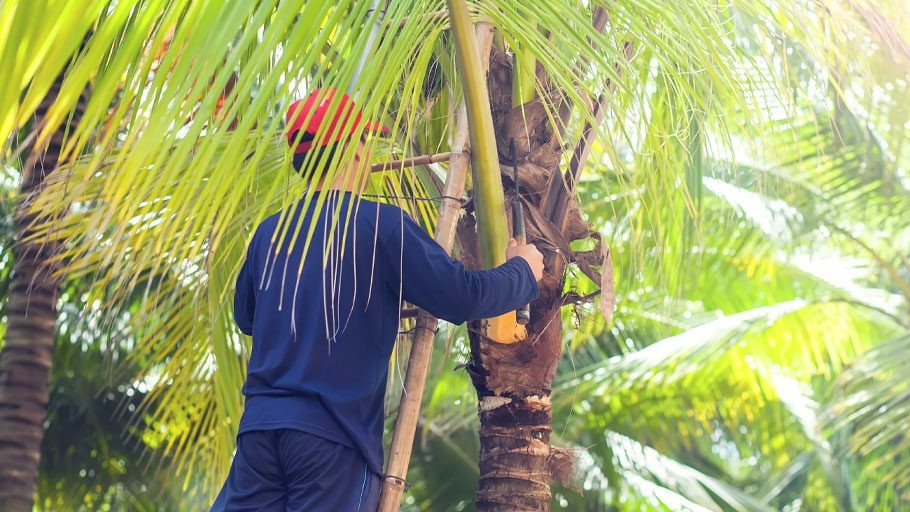Palm trees symbolize tropical paradise, their majestic fronds swaying in the warm breeze. But like all plants, they require regular maintenance to remain healthy and attractive. That’s why pruning is an essential aspect of palm tree care.
Pruning palm trees promotes growth, prevents disease, and enhances their appearance. Those pruning palm trees should exercise safety precautions when trimming these tall beauties. The parts of the tree that require pruning include dead and yellowing fronds and the suckers and seed pods.
Since palm tree pruning can be a precarious exercise, it’s advisable to enlist the help of a partner who can hold your ladder and assist in other ways. Additionally, it would help if you timed pruning carefully to offer an ideal time for recovery and growth.
How to Prune Palm Trees

If you’ve never pruned a palm tree, it’s time for a learning curve. Although beautiful, palm tree fronds can inflict a nasty wound or deep splinters if not approached carefully. Read the fourteen steps below to explain how it’s done:
1. Select the Correct Tools and Follow Safety Precautions
Gather the necessary tools before pruning your palm tree, and consider safety precautions. The tools you will need include the following:
- Pruning shears or loppers for small fronds
- A saw for larger fronds or trunk trimming
- Safety goggles to protect your eyes from shavings and debris
- Gloves to safeguard your hands
- A ladder or pole pruner for those hard-to-reach fronds
- A disinfectant solution to clean the tools between cuts.
Here are the safety precautions to consider when pruning palms:
- Wear closed-toe shoes and appropriate, hardy clothing.
- Ensure your ladder is stable and on level ground.
- Assess for obstacles like power lines.
- Work with a partner if pruning large palm trees.
2. Assess Your Palm Tree
Before cutting, examine your palm tree from top to bottom. Identify the dead, yellowing, or damaged fronds you plan to remove. Look for challenges, obstacles, or potential dangers, like bee hives, nests, and electrical wires.
3. Start at the Bottom
It’s advisable to start pruning from the bottom up, given how the palm fronds overlap. Use your pruning shears or loppers for fronds within your reach, and trim them as close as possible to the trunk without damaging it.
4. Remove the Dead Fronds
When pruning a palm tree, you must remove the dead fronds as close to the trunk as possible. Dead fronds detract from the tree’s desired appearance and serve as a breeding ground for insects, unwanted pests, and diseases.
5. Trim the Yellowing Fronds
Yellow fronds on a palm tree indicate a lack of nutrients. It is suggested you trim the yellowing fronds but leave the green ones to continue with photosynthesis that provides food for the palm.
6. Cut Back the Green Fronds
The green fronds on a palm tree should be pruned sparingly. Prune only those obstructing pathways, structures, power lines, and sightlines if necessary.
7. Attend to the Seed Pods and Fruit
If your palm tree produces seed pods and fruit, consider whether you want to allow them to mature. Removing them can help redirect the palm’s energy to trunk and frond growth.
8. Clean the Trunk
Assess the trunk lines and carefully trim any old leaf bases attached to the trunk. Doing this helps to enhance the palm tree’s aesthetics and reduce the hiding places for pests.
9. Ensure You Have a Partner when Trimming Taller Palm Trees
If the palm tree you’re pruning is particularly tall, you must use a ladder to reach the higher fronds. Enlist the help of a partner who can hold your ladder and pass you tools, and be sure to exercise caution.
10. Prune the Suckers
If your palm tree has suckers (the small shoots growing from its base), it is better to remove them. This helps to redirect growth energy to the trunk and foliage.
11. Disinfect Your Tools
Just like medical apparatus that must be sterilized between patients, it’s good practice to sterilize your pruning tools between cuts. Doing this helps to prevent the spread of diseases or parasites between plants.
12. Always Observe Safety Measures
Throughout the pruning process, it is essential to prioritize your safety and those around you. Be mindful of your surroundings – especially when using ladders and power tools.
13. Fertilize and Water Your Palm Tree
After the shock of pruning, your palm tree will require some extra care. You can provide this with a balanced palm fertilizer and ensure you water it sufficiently to support regrowth.
14. Dispose of Pruned Material Properly
As a responsible homeowner, you should appropriately dispose of pruned fronds and other garden material. Avoid dumping offcuts in natural areas, as they can become a breeding ground for invasive pests and diseases that could affect the local ecosystem.
Instead, consider mulching or composting the trimmings. If this is not feasible, contact your local waste disposal service for guidance on proper waste disposal methods for garden refuse.
Why Prune Palm Trees?
While it might seem odd or challenging to prune palm trees, there are key reasons for doing so. They include the following:
- Aesthetics: Trimming palm trees of dead and unsightly fronds improves their overall appearance and enhances your landscape’s beauty.
- Palm tree health: Pruning palm trees helps eliminate diseased or pest-infected fronds and lowers their chances of harm.
- Safety aspects: When pruning palm trees, you remove dead or hanging fronds that could fall and are dangerous to people, animals, and surrounding properties.
- Palm tree growth: Correct palm tree pruning methods can promote new growth and encourage the development of a more robust structure.
When to Prune Palm Trees
The best time to prune your palm tree is late spring or early summer. Pruning during this time allows the palm to recover quickly and flourish during its growing season. It’s better to avoid pruning during fall or winter, as palm tree growth is less active during these seasons. In fact, cutting fonds during this time can hinder the palm tree’s growth.
Ideally, it would help if you don’t wait until your palm tree is severely overgrown or has several dead fronds before pruning. Doing so can make pruning more challenging and potentially harm the tree.
Final Thoughts
Pruning palm trees forms an essential part of their care and maintenance. Well-timed and careful pruning enhances a palm tree’s beauty, promotes growth and health, and ensures the safety of those around it.
This step-by-step guide reminds palm pruners to take the necessary precautions when trimming their palms so they can enjoy their tropical elegance and vitality for years to come.

